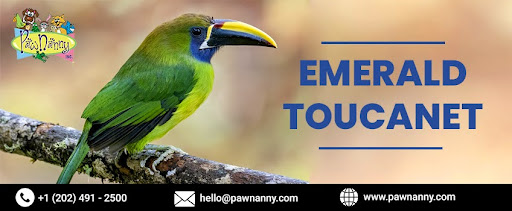
Emerald Toucanet
Scientific Name: Aulacorhynchus Prasinus
Flock Members: 2-20 members
Size: 12.6-15 inches
Weight: 4.9-6.7 ounces
Lifespan: 15-20 years
A.K.A.: Green-billed Toucanets
Behavior
The behavior of the Emerald Toucanet is fascinating and characterized by unique traits and interactions within their natural habitat. These medium-sized birds exhibit distinctive behaviors that contribute to their survival, social dynamics, and communication, even during pet overnight services. Emerald Toucanets are known for their vibrant plumage, which serves multiple purposes. Their bright green feathers help camouflage them amidst the lush foliage of the tropical forests they inhabit, providing protection from predators. Additionally, their colorful appearance and striking beaks play a crucial role in communication and courtship displays.
These birds are primarily arboreal, spending most of their time in the trees. They move with agility and grace through the canopy, using their strong beaks to reach for fruits and berries. Emerald Toucanets are social birds, often seen in small groups or family units. They communicate through a variety of vocalizations, including croaks, clucks, and chattering sounds. Courtship displays are essential for pair formation. Males engage in elaborate behaviors, such as hopping, wing-flapping, and vocalizing, to attract a mate. They may also engage in mutual preening and feeding rituals as a display of affection.
The Emerald Toucanets showcase their adaptability to the forest environment, their social interactions, and their unique breeding and parenting strategies, and need constant attention during pet overnight stays. These behaviors contribute to their ecological role as seed dispersers and their significance as captivating and charismatic inhabitants of the tropical rainforests.
History
The history of the Emerald Toucanet spans centuries and is intertwined with the tropical regions of Central and South America where these birds are found. Emerald Toucanets have a long and rich natural history. They have been admired for their vibrant plumage and unique beak since ancient times. Indigenous cultures in the regions they inhabit often revered them, considering them symbols of power and beauty.
The scientific exploration and formal documentation of the Emerald Toucanet began in the 18th and 19th centuries, as naturalists and explorers ventured into the rainforests of Central and South America. These intrepid individuals cataloged and described the diverse flora and fauna, including the stunning avian species they encountered, such as the Emerald Toucanet. Throughout the years, Emerald Toucanets have captivated bird enthusiasts, both amateur and professional. Their striking appearance, characterized by bright green plumage, chestnut breast, and distinctive black markings, has made them popular subjects for art and photography.
The beauty and allure of the Emerald Toucanet led to its introduction into aviculture. These birds are now bred in captivity for their aesthetic appeal and gentle nature. They have found homes in zoos, aviaries, and private collections worldwide, contributing to the preservation and conservation efforts for this species. Despite their historical and ongoing popularity, Emerald Toucanets face challenges in the wild due to deforestation and habitat loss. Conservation efforts aim to protect their natural habitats, raise awareness, and support sustainable practices to ensure the survival of these remarkable birds for future generations.
The history of the Emerald Toucanet is a testament to the enduring fascination and appreciation for their beauty, as well as the importance of conservation efforts to preserve their natural habitats and safeguard their place in the avian world.
Breeding
Breeding in the Emerald Toucanet is an intricate process that involves courtship displays, nest construction, incubation, and parental care. During the breeding season, male Emerald Toucanets engage in elaborate courtship displays to attract a mate. These displays often involve flapping their wings, hopping from branch to branch, and vocalizing with a series of calls and croaks. These displays showcase their vibrant plumage and establish their reproductive fitness. Once a pair bond is formed, the male and female work together to find a suitable nesting site. They prefer tree cavities, often excavating their own or utilizing natural hollows or abandoned woodpecker nests. The female lays a clutch of 2 to 4 eggs, which she incubates while the male assists in providing food.
Incubation lasts for about 16 to 18 days, during which both parents take turns sitting on the eggs. Once the eggs hatch, the parents feed the chicks regurgitated food, ensuring their growth and development. The chicks are initially blind and helpless but quickly grow and develop under the care of their parents. Parental care continues after the chicks fledge, with the parents providing food and guidance as the young birds learn to fly and forage. This period of parental care can last several weeks until the young toucanets gain independence.
Food & Nutrition
Proper food and nutrition are vital for the health and well-being of Emerald Toucanets. These birds have specific dietary requirements that should be met to support their vibrant plumage, overall health, and vitality - something that needs to be taken care during overnight stays services for pets.
In the wild, Emerald Toucanets primarily feed on a diverse range of fruits, berries, and insects. As pets or in captivity, their diet should replicate their natural feeding habits as closely as possible. A high-quality commercial toucan or softbill pellet mix serves as a nutritious base diet. These pellets are specially formulated to provide essential vitamins, minerals, and balanced nutrition. Supplementing their diet with fresh fruits is crucial. Offer a variety of chopped or sliced fruits such as bananas, apples, oranges, grapes, and berries. These fruits provide natural sugars, vitamins, and antioxidants. It is essential to ensure that the fruits are ripe and free from any pesticides or harmful chemicals.
In addition to fruits, Emerald Toucanets may benefit from occasional protein sources. Offer small amounts of live or frozen insects such as mealworms, crickets, or wax worms. These protein-rich treats mimic their natural diet and can be provided a few times a week. Fresh, clean water should be provided at all times for hydration. Ensure that the water is changed daily to maintain cleanliness.
Conclusion
The Emerald Toucanet is a captivating bird that brings joy and fascination both in the wild and as a pet. Understanding their behavior and needs in these two settings is essential to appreciate and care for them appropriately.
In the wild, Emerald Toucanets are found in the lush tropical rainforests of Central and South America. They thrive in the dense canopy, where their vibrant green plumage helps them blend seamlessly with the foliage. In their natural habitat, they engage in various behaviors such as foraging for fruits, berries, and insects, hopping from branch to branch with agility, and vocalizing to communicate within their social groups. They play an important ecological role as seed dispersers, aiding in forest regeneration. As pets, Emerald Toucanets are cherished for their striking appearance, gentle nature, and playful personalities. However, they require specialized care and a suitable environment to thrive. Providing a spacious aviary with plenty of perching branches and enrichment is crucial. A well-balanced diet of toucan or softbill pellets, supplemented with fresh fruits, is necessary for their optimal health. Regular social interaction and mental stimulation are also important to keep them happy and fulfilled as companion birds.
Whether in the wild or as pets, Emerald Toucanets bring beauty and charm. In their natural habitat, they contribute to the biodiversity of the rainforest ecosystem. As pets, they can bring joy and wonder to their owners, offering a unique and engaging avian companion. Respecting their natural behaviors and providing them with appropriate care allows us to appreciate their innate beauty and contribute to their overall well-being. For more information or to avail our pets overnight stays services Fairfax VA, visit Pawnanny.com .










